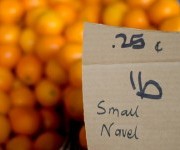 It’s time for people who care about food to quit navel-gazing.Photo: Jared WongThe food movement has a case of multiple-personality disorder.
It’s time for people who care about food to quit navel-gazing.Photo: Jared WongThe food movement has a case of multiple-personality disorder.
One of its personalities is the foodie, who approaches the movement as a vehicle to increase sensual-aesthetic pleasure. Another of its personalities is the localizer, who views the movement through the lens of the foodshed radius and food miles. Another is small-is-beautiful — small farms, small artisan processors, small distributors. Two more of its personalities are the food-justice advocate and the broadener, who want the movement to expand to a robust, durable, fair, and deeply embedded system that really challenges the stranglehold that the industrial food system has on us.
If you look at the literature, the news media, the blogosphere, Twitterdom, and Facebookland, you’ll find that foodie-ism, local-ism, and small-ism are the dominant personalities, with a smattering of food justice and broad-ism here and there. You’ll find plenty of foodies slobbering over whipped Mangalitsa lard, braised pork snouts, and sliver-thin raw beef’s liver. You’ll find plenty of localists committing themselves with verve to the 100-mile challenge. You’ll find heaps of praise for all things small-ish.
What you’ll find little of is a critical line of thinking that asks a simple question: Can foodies, localists, or smallists supply our communities? What does whipped Mangalitsa lard have to do with feeding people? What is the true foodshed radius of 10 million people? At what cost, “small is beautiful”?
There is no question that the dominant personalities of the movement have gotten us where we are today. But where is that? We’re at a substantial and exceedingly definitive crossroads, with a deceptively simple question looming before us: What is important to us? The answers to that question will determine our choice of direction and the personalities of the movement for years to come.
As a broadist, I know what is important to me, and since I am a reformed localist and smallist, I have a sense of what is important to them. However, I am not sure about the foodies. Sometimes I think all that really matters to them is sensuous pleasure, gastronomic hedonism, couched in the language of localism. Let me be clear: there is a place for the sensuous pleasure of braised pig testicles, just as there is a place for tight radii and for smallness. I have no problem with multiple personality disorder; it can, in fact, be a good thing. I just want to have our multiple personalities engage each other in a critical discussion about what is important to us.
We should take the considerable momentum that the foodies, localists, and smallists have given the movement and turn it into something grand, something powerful, something that can move and change cultures.
But what does change mean for the movement?
First, that it will truly be a movement, rather than something that we, perhaps out of romanticism, call a movement.
Second, the movement needs to see that it is first and foremost a deeply ethical movement, and that its broad ethics trump the parochial ethics of foodism, localism, and smallism. The movement has an ethical obligation to feed all people in its foodsheds, especially those most harmed and marginalized by industrialism, not just the small percentage of us who embrace foodism, localism, and smallism. The movement has an ethical obligation to surrender its parochial interests to the broader interests of the masses while at the same time challenging, pushing, and changing those interests. To be blunt, the movement has an ethical obligation not to advocate for the impossible — foodists, localists, and smallists can only feed themselves, no matter their intentions, no matter how fervent they are.
Third, real change means getting real food — recognizable, familiar, comfortable — into the hands of tens of millions of people who otherwise would never see it and might never want it. This does not mean I think chains like Chipotle Grill should be the model. Given the choice by the Corbin Hill Road Farm program — which connects upstate farms with people in New York City’s low-resource communities — the people of the South Bronx came out in droves for simple, fresh, real, and good produce. Participation leapt from about 250 last year in its first season to 1,500 shares this year. How can we build upon that momentum?
Fourth, and finally, change means work — hard work. First we need to convince ourselves and then we need to convince as much of the rest of the population as possible.
So let’s get to work feeding ourselves and our communities — with ethics, ecology, and justice.




